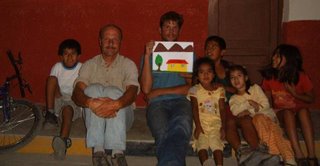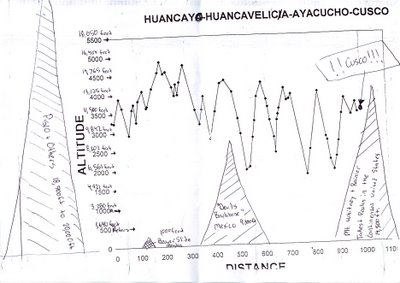The scenery from this stage justifies two separate Gallery photo albums, one from my time on the bicycle and another from the three weeks I spent trekking and climbing in the Andes. However, this trip report only covers my experience on the bicycle, I will publish a journal of my experiences on foot in a few weeks.In Stage 3, Part 2, I left the desolate Peruvian coast and traveled from sea level through a series of incredible tunnels, canyons, and high passes to the Cordillera Blanca mountain range of the Andes. From there, I set out for the town of Huaraz, the trekking and alpine climbing mecca of South America. In Huaraz, I lost myself for 3 weeks as I hiked over 200 miles through some of the most spectacular mountains in the world. I capped off the stage by summiting 18,900 ft. Mount Pisco before traveling for 50 hours back home to Seattle for my best friend´s wedding. If the remainder of my trip provides only 10% of the experience of the past month, I will be a happy man.
This stage began with a whirlwind cultural tour of the Peruvian coast which included the desert ruins of Chan Chan, the Pyramids of the Sun and Moon, and a day lounging in the beach town of Huanchaco to watch the fisherman surf on their traditional Caballitos de Tortora, or reed rafts. Lucho, our host and head of the local bicycle club asked if we would help with his annual community bicycle race and I had great time photographing the event. The next day, I pedaled south out of town through a bleak coastal desert with my Dutch, German, and Flemish cycling companions.
Our adventures began as we traded the smooth asphalt and heavy traffic of the Pan American Highway for the bumpy solitude of a private hydroelectric dam access road and defunct 1930´s railway line operated by Charlotte Carolina based Duke Energy. For 4 days, we climbed non-stop from sea level over the Cordillera Negra through a series of 38 tunnels that carved through the Canon de Pato along the Rio Santa. This route was incredibly scenic, remote, and bone-jarring.
In the small village of Huallanca, the local hotel proprietor exclaimed ¨yes, many tourists come here, my hotel is always full¨. I snuck a peak into the hotel logbook and discovered that we were only his second group of guests in the past month. In ¨a small world afterall¨ moment, I recognized the name of his last guest, Colin Champion from England. I traded emails with Colin almost 3 years ago after pouring over his
Web site that chronicles his bicycle tours around the world. His trip reports were a key inspiration for Ribbon Of Road.
Two days later, I bumped into Colin at the local ice cream slinger´s stand in Caraz town, he was in the middle of a three week cycling tour through the Andes. Later that evening, Colin, his wife Tracy, Harald and I enjoyed beersks together in a dimly lit posada bar on the outskirts of Caraz. Colin unleashed an arsenal of maps and route guides--German maps, Peruvian military maps, general tourist maps, topographical maps. He must have sensed my awe over his level of preparation, ¨Gregg, you have been cycling for 12 months, I have been planning for 12 months¨ he said with an ear to ear grin. His route included a punishing dirt road circuit that cut directly through the Cordillera Blanca, with 22 peaks over 19,500 feet, the second highest mountain range in the world.
The next morning, Harald, Wouter, and I decided that Colin´s route plan sounded like fun and we pedaled out of Caraz with the Cordillera Blanca on our minds. That evening, I found myself camped in the middle of a cow pasture, at 13,000 feet, in a frozen tent, with a terrible headache, dry heaving from altitude sickness, and thinking ¨oh shit, this isn´t so much fun¨. My nausea finally passed at 3am and a few hours later I began the long, zigzagging ascent to the top of 15,600 foot Portachuelo de Llanganuco Pass, one of the highest in the world. This shattered my old altitude record by 3,500 feet and I was so dizzy at the top that I could barely hold my bike upright. For the next five days, the landscape and my cultural interactions along this circuit exceeded my wildest expectations for what this trip could be. As a cyclist, traveler, and wanna be photographer, my passions were fully engaged and I experienced some of the more perfect moments of my life.
A few days into the circuit, I wandered into a small adobe house of an indigenous family. The matriarch, appalled by my shabby appearance, offered to give me a haircut. Word of my arrival spread quickly and the house soon filled up with single indigenous women from the local village. For an hour, while the scissors snipped away, I watched Donald Trump´s Miss America Pageant in English, dubbed in Spanish, in a room full of gossiping indigenous women who couldn´t speak Spanish but rather Quechua, the traditional language of the Incan culture. The matriarch was our translator and I was bombarded with the same question over and over again, ¨why aren´t there any Peruana women in your Miss America Pageant?¨. I surprised myself with my knowledge of international beauty competitions as I explained that the winner of Miss America would qualify of Miss World where there would likely be a nice Peruana to compete against. My answer didn´t satisfy the chatty gallery but did lead to some entertaining responses;¨no, they do not let the Peruana women compete because your pasty gringas have no chance against us¨, and ¨our homes and villages my be dirty with garbage but the love of the Peruana woman is too clean and strong for the Gringo...that is why they do not let us compete!¨. The matriarch put down her scissors and dumped what felt like a gallon of gel into my hair, greased it back and exclaimed ¨now you are handsome and I will let these women will rob your heart¨. At that moment, I realized that this whole thing was a set-up, I leapt up out of my chair and dashed back to the village to find Harald and Wouter.
At dinner that evening, I met another indigenous woman and told her about my nausea at altitudes over 12,500 feet. She disappeared into the kitchen and returned a few minutes later with a large plastic bag full of what looked like tea leaves. ¨These are Coca leaves¨ she explained. ¨They are the traditional plant of the Inca and we use them to give energy and prevent altitude sickness¨. We practiced chewing them together and I felt no effect whatsoever. (no mom, Coca leaves are not cocaine, cocaine is the end product after they are chemically processed) The next day, while cycling up and over 16,200 foot Punta Olimpica Pass I started to get a headache and thought, what the heck, and stuffed a huge handful of Coca into my cheek. About ten minutes later something really strange started to happen. I began to notice that all of the men along the roadside were chewing Coca too. They went out of their way to acknowledge and cheer me on. They spoke to me in Quechua and I understood them. My vision got wavy and then the mountains started speaking to me. Everyone was saying the same thing, ¨we are the children of the Inca, this is our home, and now you know¨. My pace increased and I cycled effortlessly up a long ascent that would have normally left me completely exhausted. Thirty-minutes later, I snapped out of my trance and pulled off the road to lie down on a soft grassy patch. Wouter caught up to me, ¨wow, you just took off back there, what happened?¨. The Coca leaves¨, I answered, ¨either I´ve gone completely mad or I think that I just got really stoned off those Coca leaves¨.
Six days after leaving Caraz, I hobbled in to the tourist center of Huaraz with a sprained thumb and bruised hip from a crash while coming down from Punta Olimpica Pass and a scraped knee from tripping over a completely random hawk while making an early AM bathroom run. My body had seen better days but my curiosity was peaked, my new fascination was this incredible mountain range and I wasted no time booking a 10-trek through the Cordillera Huayhuash to further explore the region.
I spent the next three weeks hiking over 200 miles through the Andes and summiting the incredible 18,900 ft. Mount Pisco. My experience in the Cordillera off the bike justifies it´s own journal entry but that will have to wait until after I return to Peru from my best friend´s wedding in Seattle on the 26th of August.
Stage 3, Part 2 StatsMiles: 328.4 miles (plus 200 miles on foot)
Elevation Gain: 32,047 ft.
Flat Tires: Gregg 1
Overall Expedition Stats Miles: 11,049.1 miles (not including around town miles)
Flat Tires: Gregg 13
Sponsored by: Co-Motion Cycles, Outdoor Research, Ortlieb, Rudy Project, ThinkHost, eRoi, Schwalbe North America, ZUM, Bay Club, Canright Interactive, R Bar, IBEX, Lombardi Sports, Jaunt

